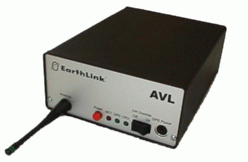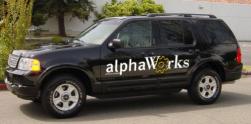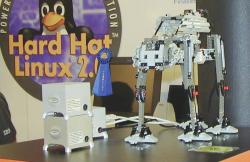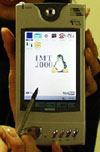A walk on the embedded side . . . of LinuxWorld SF 2001
Sep 1, 2001 — by Rick Lehrbaum — from the LinuxDevices Archive — viewsThis week, the world's largest Linux-oriented conference was held in San Francisco, CA — the LinuxWorld Conference & Expo. Despite the current worldwide economic downturn, the show's organizers announced earlier this summer that pre-registrations for the show had broken all previous records, and optimistically predicted an attendance of over 20,000.
Although the actual attendance count is not yet available as of this writing, it is clear that attendance fell far below the predicted number. [Update: the numbers are now in, and the official tally for LinuxWorld SF 2001 attendance is 18,000.]
Overall, everyone agreed that the atmosphere this year was much more subdued than at last year's West Coast mega-event. Consistent with the slump in the economy, the number of exhibitors dropped off — down to around 150, from over 200 last year — as did the volume of news and new product announcements.
Embedded Linux on the rise
Despite the disappointing turnout and diminished level of enthusiasm at the show, there was near-universal agreement that one thing seemed to have grown stronger over the past six to twelve months — Embedded Linux. Although LinuxWorld does not focus on the embedded market, a host of new products, technologies, and strategies catering to the needs of embedded system and smart device developers and manufacturers was unveiled and showcased. Everywhere you turned, you ran across companies embedding Linux inside PDAs, entertainment devices (especially TV set-top boxes), automotive telematics systems, thin clients, etc.
In the past, Embedded Linux products and technologies accounted for roughly 10 percent of what was showcased at LinuxWorld. At this show, the Embedded Linux fraction seems to have increased to around 15-20 percent. Not surprising, given the strong growth in developer interest in Embedded Linux reported in recent months by market analysts VDC (story), Evans Data Corp (story), and others (story).
CNET News.com's roving camera picked up some of the “Linux-in-devices” action on the show floor. Here's a short video clip about several cool Embedded Linux based devices, including one implementation of Linux on Compaq's iPAQ, Earthlink's experimental telematics device, and HP's Digital Entertainment Center . . . play clip.
As is our tradition, LinuxDevices.com brings you the following end-of-show summary of “all things embedded and embeddable” at LinuxWorld Expo & Conference (in alphabetic order). See you next LinuxWorld.
Applied Data Systems — visitors to ADS' booth were treated to a dazzling array of LCD-adorned StrongARM based single-board computers — truly a hardware geek's paradise! ADS has created their own Embedded Linux implementations which are offered as an option with all of their SBCs, but in addition was showcasing three Java-enabled graphically-oriented application environments: Insignia's Jeode VM running on Lineo's Embedix; IBM's VisualAge Micro Edition running on MontaVista's Hard Hat Linux; and Blackdown's JDK running on ADS' own flavor of Embedded Linux. ADS also announced this week that they have been selected by Intel as a third-party platform provider for Intel's StrongARM and XScale processors, and will be developing a modified version of their Graphics Master SBC for use as a reference platform by Intel customers.

Century Embedded Technologies — Century occupied their usual position at a pedestal within Red Hat's large pavilion. Century's big announcement at the show was PIXIL, a re-spin and enhancement of its previous key products (Microwindows and ViewML) into new suite of graphical environments, tools, and applications targeting Linux-based PDAs, webpads, and thin client devices. Demonstrations included PIXIL running on a Compaq iPAQ PDA, as well as a PIXIL-based set-top box based on National Semiconductor's SP1SC10 set-top box development platform. Greg Haerr (Century's CEO) made the claim that, whereas the TV Linux Alliance project is just at the point of beginning to define standards, Century/National's newly announced Linux4.TV is available for immediate use by customers, and already provides support for both digital and analog TV, personal video recorder (PVR) functions, and APIs for both kernel and middleware software interfacing.
CodeWeavers — demonstrated the recently announced Crossover technology which allows Linux systems to use Windows browsers and application helpers. According to Jeremy White (president), an embedded version of Crossover is being developed which will occupy on the order of 1MB of RAM and 4.5MB of storage. Unfortunately, the Windows plugins are sometimes quite greedy in terms of the system resources they require in order to run under Crossover. CodeWeavers, a driving force behind WINE, can provide services for getting embedded applications to run on Linux under WINE, or can port the apps directly to Linux APIs.

Embedded Linux Consortium — the ELC announced that several new members have joined recently, including Future Sound Technologies, Intel Corporation, American Megatrends Inc., Aleph One, Ltd., and Vibren Technologies. Based on the roster at the ELC website, the consortium currently has 68 corporate members (36 executive and 32 affiliate level). One bit of hot news is that the ELC's board of directors recently approved a change to the ELC's bylaws to allow the ELC to own intellectual property, thereby clearing the way for ELC to engage in developing and licensing Embedded Linux standards.
Embedded Linux Journal — on the opening day of LinuxWorld, the ELJ announced the winners of their first Embedded Linux design contest. Each winner gets an all expenses-paid trip to Costa Rica!
Empower Technologies — demonstrated their new LinuxDA “Linux upgrade” for the Palm III and V. They also announced that LinuxDA has been licensed by two Palm-compatible Taiwanese consumer device manufacturers, Elitegoup Computer Systems and APlux Communications


Lineo — in contrast with last summer, when Lineo occupied multiple locations on the show floor due to having acquired several other Embedded Linux companies, Lineo was not an exhibitor this time, but instead held a press conference to make several strategic announcements. These included: the selection of Lineo's Embedix Digital Media core by Motorola for use in the DCT5000 set-top box (story); and the planned release of a “GPL Compliance Toolset” to help developers and their companies identify what licenses govern their software and what the implications of those licenses are (story).
Lisa Systems — if you ask Compaq when (or where) you can get an iPAQ with Linux preinstalled, they'll probably refer you to Lisa Systems. Lisa demonstrated their iPAQ/Linux combo, which makes use of Trolltech's Qt/Embedded as its GUI framework, at a pedestal in Compaq's large LinuxWorld pavilion.
LynuxWorks — like Lineo, LynuxWorks decided not to have their own booth at LinuxWorld. They did, however, have a small presence at a pedestal within Intel's pavilian, where they demonstrated their port of BlueCat Linux to Intel's Internet Exchange Architecture (IXA).
MontaVista — like a “show within a show”, MontaVista's large pavilion-style booth was bristling with product and technology demonstrations. Beneath a giant hardhat-adorned Tux suspended from the convention hall ceiling (pictured here with MontaVista founder and CEO, Jim Ready), were . . .
- a demo of Hard Hat Linux (HHL) 2.0's cross development tools targeting an Alchemy AU1000 system-on-chip based set-top box reference platform. The use of the new KDevelop IDE was also being shown, as were MontaVista's Target Configuration Tool and newly GPLed Library Optimizer Tool.
- a demo that dramatized the improvement in interrupt latency that can be obtained using MontaVista's “fully-preemptable kernel” enhancement, in which streaming audio was being played in a system that was under a heavy load (repeated disk saves). Interrupt latencies were captured and graphed for visual comparison.
- a demo of MontaVista's newly announced High Availability Framework, in which a CompactPCI based Linux system was shown to reliably maintain a video display from a network-based streaming video source while one or more of three Ethernet cables were disconnected.
- a set-top box demo based on HHL and the recently announced Hard Hat Graphics running on IBM's “Redwood” PowerPC 405 based reference platform.
- HHL running on an iPAQ PDA, using two approaches — Hard Hat Graphics, and Trolltech's Qt/Embedded — including demonstration of both tools' GUI-builder development methods.
- demos of two IBM products: Visual Age Micro Edition, a Java-like VM; and ViaVoice, speech recognition software that supports both desktop and embedded systems. ViaVoice-based speaker independent command and control can supposedly fit within 200KB of RAM.

- a delightful demonstration of Embedded Linux based machine control, in which Intrinsyc's tiny StrongARM-based CerfBoard SBC running HHL was shown controlling the walking of a Lego MindStorm Robot that looked like something out of a Star Wars movie.

Red Hat — Joe deBlaquiere (senior engineer) demonstrated a pre-release version of a new Red Hat “Embedded Linux Developer Kit”. The tool is meant to make it easy for developers to embed Red Hat Linux. According to deBlaquiere, the tool makes use of standard Red Hat SRPMS, so it “leverages the stability of Red Hat Linux transitioned to the embedded space.” A number of predefined baseline configurations are available, including minimum bootable system, minimum networked system, etc., to which developers can add whatever they require by means of an easy-to-use GUI-based configurator. One unique aspect to Red Hat's target OS builder approach, according to deBlaquiere, is that unlike Lineo's LIPO and MontaVista's LOT, Red Hat's library reduction/optimization process makes use of the four defined EL/IX profiles, with the result that embedded systems will be characterizable as being compliant with a specific well-defined API set. Additionally, Red Hat's RedBoot debugger/bootloader has been integrated into the new Embedded Linux kit as a standard component. deBlaquiere said the first beta release of the new kit is expected within a few weeks. Speaking of which, both RedBoot and Red Hat's “other OS”, eCOS, were also being demonstrated in Red Hat's pavilion.
RedSonic — demonstrated four new products, including: Secure SOHO, a gateway/firewall software solution; Windows-Based Terminal, software that provides thin-client Linux-based access to Windows applications and services; LinuxBIOS, a ROM-based Linux kernel that replaces legacy BIOS code for secure, fast boot; and a REDSonic PowerPC starter kit for the MPC 823. RedSonic also showcased an interesting customer application: SignSite, manufactured by Clarity Visual Systems, is a bright, full-color “digital billboard” that is used for advertising and information display in public places. The device contains an embedded Ampro Encore 500 Pentium-based SBC running RedSonic's REDICE-Linux OS.
RidgeRun — demonstrated DSPLinux running on TI's digital still camera reference platform based on the TI TMS320DSC21 dual-core (RISC + DSP) system-on-chip processor. That chip, according to Rudy Prince (RidgeRun CEO) is used in several high-end digital cameras from HP and Kodak. Also demonstrated was the DSPLinux development environment's very slick “appliance simulator”. Can we expect to find DSPLinux inside digital cameras sometime soon? “Yes,” replied Prince. Embedded Linux will play a browing role in devices that feature Ethernet, 802.11, or Bluetooth connectivity and other high-end functions, according to Prince.
The SH/Linux Project — while passing by the Japan Linux Association's booth in the .org area, I noticed some demos of Linux running on two Japan-manufactured game machines — Sony's PlayStation 2 and Sega's Dreamcast. The former, based on Sony's recently released PS2 SDK, and the latter, based on efforts of the Linux-SH project.
Tuxia — demonstrated their TASTE Embedded Linux running on a new set-top box reference platform, and also on some very nice looking thin client systems. They also gave the first LinuxWorld demonstration of their TASTE OS running on an iPAQ PDA. The iPAQ demo included TUXIA's Nanozilla small footprint browser with 802.11 wireless web connectivity. The company issued two key news announcements in conjunction with the show: an agreement with system-on-chip maker Rise to support Rise's SOC's with TASTE Embedded Linux (story); and the selection of TASTE as the Embedded Linux OS for a new consumer media gateway reference platform being developed by Intel (story).
Transvirtual Technologies — TVT was showing TV set-top box and PDA applications for its new Java/XML/Linux based XOE architecture.

This article was originally published on LinuxDevices.com and has been donated to the open source community by QuinStreet Inc. Please visit LinuxToday.com for up-to-date news and articles about Linux and open source.